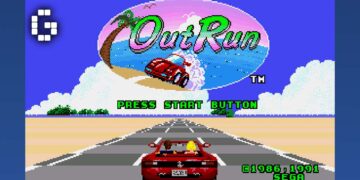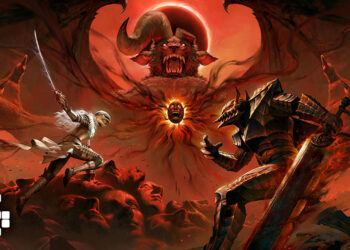There’s nothing quite like the classics. Tactics Ogre: Reborn is the latest iteration of what is often considered one of the most important tactical RPGs in the genre, a game that would go on to inspire Final Fantasy Tactics, and Triangle Strategy. A story of political warfare, complex chess-like gameplay, and highly detailed customization.
If you’re into RPGs or Strategy games, there’s a good chance you’ve heard of Tactics Ogre somewhere through the grapevine but you should also know that this latest version, a remaster of the PSP version of the game maybe it’s the best iteration yet. Reborn keeps to the spirits of previous Tactics Ogre’s while a number of quality of life improvements. It’s still a little by dated modern standards but for a game from the Golden Age of JRPGs, Tactics Ogre remains brilliant even 20 years later.
Story

Tactics Ogre takes place on the Island of Valeria, where three factions: Bacrum, Galgastan, and Walister are vying for power. Three young fighters: Denam, Catiua, and Vyce are plotting to fight back against Galgastani influence but soon find themselves recruited by the Walister Resistance. From here they find themselves tangled in a web of history, politics, and betrayal.
This may sound similar to the Medival thriller plots of FF Tactics or Fire Emblem but remember, Tactics Ogre was one of the first to attempt weaving dark high fantasy into a strong narrative. While the game can be hard to follow at times with all the different groups, agendas, and hidden agendas thrown around, it’s humanized through the main characters. Denam and Catiua lost their village to war, and you can see how the different choices weigh down on their minds. The game never shies away from the horrors of war with the player themselves being forced to choose and partake in some truly heinous actions.
Reborn has also added full voice acting to the game and each character sounds fantastic. The cast gives a great sense of weight to the game, clearly expressing the anxiety and desperation of war while fitting the setting perfectly. The standouts for me are the intentionally obnoxious Vyce and the stern but noble Ravness. It shows how much voice acting can add to the game and make it feel more alive.
Alignment and Routes

Tactics Ogre has multiple routes and endings which can be divided into law, chaos, and neutral. Depending on your choices, units of opposing alignment may leave, different characters may live or die and some may become your enemies. It allows for an interesting tale where your choices feel like they matter. It also gives the title a lot of replay value as you’re encouraged to go back to see what happens in the other routes.

I should also note that if the story is getting too confusing, the game also includes a section called The Warren Report. This in-depth lore guide explains the history and backstory of each character and the events of the game. Not only does it help, but it’s a fascinating read on its own, telling you so much about the world to the point it feels like you reading about a real place. It can also help with the alignments, allowing you to track where different routes split off and plan accordingly for your next play-through.
The Tactics

Tactics Ogre is your traditional tactics game. Units stand on an isometric grid where they can move, attack, perform special skills, and use items. Let’s just start by saying that this game is hard. Tactics Ogre is a rather selfish game that demands hours of patience and investment from the player. Each enemy takes multiple hits to take out and can hit fairly hard back meaning even before you step onto the battlefield you’ll want to be planning which kinds of units you need and what moves they’re going to make. If the army is mostly soldiers, bring some melee fighters. If they’re mostly mages, then some archers will be better.
Much like Fire Emblem, Tactics Ogre also has permadeath. If your unit loses all its health, you have three turn cycles to revive them or they’re gone for good. Unlike Fire Emblem where you gotta use who you have, Tactics Ogre does let you recruit new units from the shops littered throughout the game. The downside to this is that new units start from level 1 with no armor or weapons. This forces you to consume a lot of time and money to get them up to speed.
Basically, you want to keep your army alive, something that’s easier said than done. Features like this should probably tell you how much you’ll like this game. If losing an hour or so of progress because one of your best dudes bled out sounds frustrating and you need to reset, you probably won’t like this game. However, if the thrill of intense battles sounds like your calling, you’ll have a lot of fun gritting your teeth through the hard-as-nails gameplay and the satisfying call of victory. Personally, I’d be lying if I said I didn’t want to put the game down a couple of times after having three of my guys slaughtered but the game is still pretty addicting. There’s something fun about thinking about where to next place your soldiers and seeing them slowly little down an enemy.
The Camera

This does bring me to one place the game hasn’t aged the best. The isometric camera angle and cramped maps can make it pretty difficult to see where your units are hitting and moving. It doesn’t help that in the story missions, there is nothing to distinguish enemy soldiers from your own, leading me to hit my own guys by mistake for than once.
The game does give you multiple camera angles including a bird’s eye view of the map but it doesn’t help much. I really wish you could manually move the camera around the map but I can see that being too difficult for a simple remaster.
I’m also not a fan of the new art style which smooths out the game’s original pixel art. It’s not the worst overhaul but it looks a little plastic-like. I would have vastly preferred the sprites of the previous versions, at least as an option.
Quality of Life

Reborn does innovate in a number of other ways though. The game now allows you to scout the battlefield before the start of missions. This means you can see each enemy in advance and plan accordingly. Battles can also be made faster with an x3 fast forward button, something that you’ll probably keep on at all times as the game is pretty slow without it.
Reborn also has the Chariot System from the PSP version. This allows you to turn back time 50 places, meaning you can save fallen units and redo parts of the battle. It’s a great feature that negates a lot of the frustration from battles while still being balanced. 50 turns isn’t a lot of time in the grand scheme of the often 45-minute-long missions but it can help with fixing smaller mistakes and prevent a few careless deaths.
Finally unlike the PSP version which had random battles on the overworld, here you instead have training battles. These allow you to grind up new units without the fear of permadeath. Even if they’re knocked out, they still get EXP making it ideal for leveling up your new units. Once again though, the game balances this out by giving your team a soft-level cap. Each unit can only reach a certain level which can only be raised by completing the next story mission. This keeps your troops from getting to OP, which may disappoint some but does keep you focused on the strategy, which is the main point of the game.
Customization

This brings us to the other big selling point of Tactics Ogre, the in-depth unit customization. As previously mentioned, you can buy new units from the store which in turn can be molded how you please.
Your troops can be equipped with weapons, armor, and spells (for magic units). They also have specific skills some of which are exclusive to their class and finishing moves: special attacks that can do loads of damage. Reborn also introduces new items called charms that allow more fundamental upgrades to the character like giving them EXP or changing their elemental affinity.
This all comes together with class changing. Every character can change classes using class marks dropped by enemies or sold at stores. From here units can further be shaped into new classes with better abilities that either suit their stats or the battlefield you’re about the enter. I noticed Denam was really good with melee weapons so I turned him into a knight, which allowed him to tank opponents with great offense and defense. If you’re the kind of player that likes to get their nose stuck in the menus, endlessly buying new selling equipment to make the perfect units, you’ll love Tactics Ogre.
Closing Thoughts

Tactics Ogre is a classic, one of the best in its genre, and beloved for a good reason. It’s not a game for everyone with its high difficulty, and awkward camera but for the hardest of the hardcode among SRPG fans, it’s more than worth your time.
Tactics Ogre Reborn, in particular, is a great remaster that boldly states “that time is now.” This latest version adds a number of quality-of-life changes that make the combat more accessible and engaging without watering down the gameplay. Training mode is a welcomed addition and the simple act of speeding up battles does a lot to lessen the frustration of battle. The candle of Tactics Ogre continues to burn strong.
| Pros | Cons |
| News voice acting makes the characters feel more alive | Camera makes it hard to see the battle properly |
| Quality of life features make the game more accessible | Smooth art style doesn't look as good as the pixelated sprites. |
| Gameplay overall is still fun and addicting, even after all these years |

Tactics Ogre: Reborn is available for Nintendo Switch, PS4, PS5, and PC via Steam.
For more information on the game, check out our interview with the game’s Producer, Hiroaki Kato, and Lead Game designer Naoyuki Takahashi.
Game copy provided by Square Enix. The game was reviewed on PS4.





![[GUIDE] SD Gundam G Generation ETERNAL Codes & How to Redeem Them](https://cdn.gamerbraves.com/2025/04/SD-Gundam-G-Generation-ETERNAL-Codes_Guide_FI-360x180.jpg)





![[SEA Exclusive] From Shadows to Shipwrecks – Jennifer English Talks About Bringing Emotional Depth to Clair Obscur: Expedition 33](https://cdn.gamerbraves.com/2025/04/Clair-Obscur-Jennifer-English_Interview_FI-360x180.jpg)

![[EXCLUSIVE] Do the Game Interview – An Intimate Look at the Challenges of Game Development](https://cdn.gamerbraves.com/2025/04/Do-the-Game_Interview_FI-1-360x180.jpg)
![[EXCLUSIVE] Interview with the Minds Behind of Den of Wolves – 10 Chambers’ New Sci-Fi Heist FPS](https://cdn.gamerbraves.com/2025/04/Den-of-Wolves_Interview_FI-360x180.jpg)










![[GUIDE] Finding Alma’s Lost Glasses in The Apple of Her Eye Side Quest](https://cdn.gamerbraves.com/2025/04/Alma-Glasses-Quest_Gudie_FI-360x180.jpg)



![[GUIDE] Farming Nightflower Pollen in Monster Hunter Wilds](https://cdn.gamerbraves.com/2025/03/MHWilds-Pollen_Guide_FI-360x180.jpg)